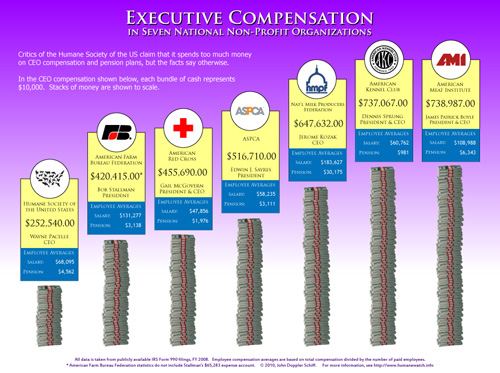 In July of 2010, David Martosko made the following statement on the HumaneWatch blog:
In July of 2010, David Martosko made the following statement on the HumaneWatch blog:
Instead of seeing my name plastered on everything, you’ll soon be reading articles contributed by various members of the HumaneWatch team. There will even be some outsiders sharing their own analysis.
Some time thereafter, Martosko’s personal biography disappeared from the HumaneWatch site.
Martosko has a substantial ego, and has always enjoyed the limelight, so his sudden withdrawal aroused our suspicions. We now know the reason for his announced departure.
On July 8th, 2010, David Martosko was arrested for yet another alcohol-related incident. He was taken into custody and charged with Class 3 and Class 4 Misdemeanor offenses: trespassing on school/church grounds at night, public swearing, and intoxication. This is Martosko’s 18th run-in with the law that we are aware of.
Martosko was previously arrested in 2008 for a number of violations, including driving while intoxicated, refusing a breathalyzer test, and drinking *while* operating a vehicle. That’s especially shocking conduct when you consider that the Center for Consumer Freedom — HumaneWatch’s parent organization — aggressively attacks Mothers Against Drunk Driving, and protests blood alcohol limits and sobriety checkpoints.
Following his newest arrest in July, Martosko has denied his erratic behavior at the Nebraska town hall meeting. He remains evasive about the events of that night, accusing eyewitnesses of “spinning tall tales”, but declining to refute any of the specific allegations made against him.
Martosko was barred from the town hall meeting in Nebraska due to his belligerence and odd behavior, which culminated in his confronting the meeting’s host, Kevin Fulton, with a recording device at a men’s room urinal. Martosko’s report on the incident only mentioned that Kevin was “reached for comment”, but unsurprisingly did not provide much detail on the location or circumstances of the attempted interview.
At the time, Martosko’s behavior seemed inexplicably bizarre. In light of his arrest on an earlier night for loitering at a church/school while drunk, belligerent, and obscene, his behavior in Nebraska makes a lot more sense.
David Martosko was granted a continuance until May 10th, 2011. We’ll let you know the outcome of that hearing and sentencing as soon as the information is available, and its impact on the HumaneWatch smear campaign.
Despite our differences with Mr. Martosko, we sincerely hope that he will find the strength to confront his addictions in the coming New Year.
Update: January 3, 2011
General VA Court Case information is now available for the trespassing charge and public intoxication/swearing.
Update: January 10, 2011
A FOIA request for the details of the incident was denied due to the criminal investigation underway against Martosko.
This correspondence is in response to your email received by the Internal Affairs Bureau of the Fairfax County Police Department in which you requested a copy of the police report and warrant associated with Mr. David Martosko’s arrest. I have determined that it is not releasable under the Virginia Freedom of Information Act. The complete police report is considered to be criminal investigation information or material. As such, it is exempted from disclosure under Section 2.2-3706 (F) (1) ofthe Code of Virginia. If I can be of further assistance please do not hesitate to contact me. Sincerely Timothy W. Field Second Lieutenant Internal Affairs Bureau 4100 Chain Bridge Road Fairfax, VA 22030 703-246-2980 FCPDFOIA@fairfaxcounty.gov
We’ll try again later this year, after Martosko’s hearing and sentencing.

 When an industry front group pretending to be a charity bashes legitimate animal welfare charities, I get annoyed.
When they try to use shelters as pawns in their smear campaign, I get furious.
Supporting shelters is admirable, and absolutely necessary to facilities strained to the breaking point. I donate to my local shelters year-round.
But HumaneWatch has managed to pervert that selfless act into a wholly selfish publicity stunt, which they’ve named “Shelter Supply Saturday”.
We call it “Whitewash Weekend”.
For the better part of a year, HumaneWatchers have been spitting on shelters and shelter personnel, while they fight spay/neuter laws, deny overpopulation, accuse shelters of profiting from their work, defend substandard breeders and animal brokers like Hunte Corp., and rail against any legislation that would ease the flood of abandoned and neglected animals into our nation’s shelters.
Now HumaneWatch is attempting to whitewash that abuse by encouraging their members to send supplies to shelters — wrapped in HumaneWatch propaganda, of course.
It will take a lot more than a dishonest greeting card to cover up HumaneWatch’s anti-animal agenda.
Shall we take a look at the scoreboard?
When an industry front group pretending to be a charity bashes legitimate animal welfare charities, I get annoyed.
When they try to use shelters as pawns in their smear campaign, I get furious.
Supporting shelters is admirable, and absolutely necessary to facilities strained to the breaking point. I donate to my local shelters year-round.
But HumaneWatch has managed to pervert that selfless act into a wholly selfish publicity stunt, which they’ve named “Shelter Supply Saturday”.
We call it “Whitewash Weekend”.
For the better part of a year, HumaneWatchers have been spitting on shelters and shelter personnel, while they fight spay/neuter laws, deny overpopulation, accuse shelters of profiting from their work, defend substandard breeders and animal brokers like Hunte Corp., and rail against any legislation that would ease the flood of abandoned and neglected animals into our nation’s shelters.
Now HumaneWatch is attempting to whitewash that abuse by encouraging their members to send supplies to shelters — wrapped in HumaneWatch propaganda, of course.
It will take a lot more than a dishonest greeting card to cover up HumaneWatch’s anti-animal agenda.
Shall we take a look at the scoreboard?
 Have you ever wanted to warn a friend about HumaneWatch, but didn’t have the time to explain?
We’ve got the answer.
The
Have you ever wanted to warn a friend about HumaneWatch, but didn’t have the time to explain?
We’ve got the answer.
The  Crush videos are so abhorrent that even members of Congress agree they need to be stopped. Nancy Perry, HSUS VP of Governmental Affairs was called before a Senate Judiciary hearing this morning to testify about the problem. The recent HSUS undercover investigation helped spotlight a resurgence of crush video activity following the SCOTUS decision invalidating the Depictions of Animal Cruelty Act.
HumaneWatch celebrated the SCOTUS ruling. In a veritable massacre of common sense, David Martosko complained that if HSUS is permitted to expose animal abusers through undercover video investigations, then crush video producers should be allowed to torture and kill pets for the sexual gratification of the viewers:
Crush videos are so abhorrent that even members of Congress agree they need to be stopped. Nancy Perry, HSUS VP of Governmental Affairs was called before a Senate Judiciary hearing this morning to testify about the problem. The recent HSUS undercover investigation helped spotlight a resurgence of crush video activity following the SCOTUS decision invalidating the Depictions of Animal Cruelty Act.
HumaneWatch celebrated the SCOTUS ruling. In a veritable massacre of common sense, David Martosko complained that if HSUS is permitted to expose animal abusers through undercover video investigations, then crush video producers should be allowed to torture and kill pets for the sexual gratification of the viewers:
 The Humane Society of the US takes a lot of heat from critics about how it manages its money. But do those complaints have any validity?
The Humane Society of the US takes a lot of heat from critics about how it manages its money. But do those complaints have any validity?